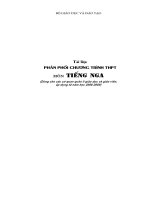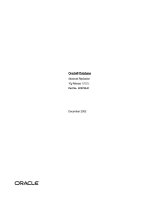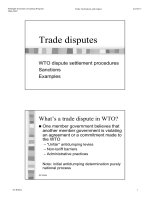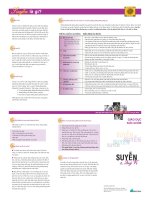Tài liệu Banking Basics pptx
Bạn đang xem bản rút gọn của tài liệu. Xem và tải ngay bản đầy đủ của tài liệu tại đây (738.54 KB, 44 trang )
Banking BasicsTable of contents
Introduction 4
What is a bank? 6
How do people start banks? 7
How did banking begin? 8
Why are there so many different types of banks? 11
How do I choose a bank? 13
What types of accounts do banks offer? 14
Is it difficult to open a bank account? 16
What happens to money after you deposit it? 18
What happens when you apply for a loan? 20
What are checks, and how do they work? 23
What is electronic banking? 25
Credit cards, debit cards, stored valued cards: What’s the difference? 27
Do banks keep large amounts of gold and silver in their vaults? 30
Why do banks fail? 31
Do you lose money if your bank fails? 34
Do you lose money if your bank is robbed? 35
How does the Federal Reserve fit into the U.S. banking system? 36
Resources for Everyone 40
Introduction
Some young savers stash their cash in shoe boxes or jelly jars. Others use “piggy banks,” which
today look more like spaceships or cartoon characters.
In any case, the same problem arises. Sooner or later, the piggy bank or jelly jar fills up, and you
have to make a decision: Should I spend the money or continue to save? And if I continue to
save, should I open a bank account or just find a bigger jar?
Maybe you’ve had to face such a decision yourself. If you decide to keep your money at home, it
will just sit there and won’t earn any extra money for you. You also run the risk that a burglar,
a fire, or some other disaster will wipe out your savings in the wink of an eye.
Then again, if you open a bank account, you can’t “visit” your money as easily as you can when
it sits in your dresser drawer. You can’t just walk into a bank in the middle of the night to
count your cash. You can’t run the coins through your fingers or toss the bills in the air and
let them rain down on your head.
Opening a bank account is a big step because you are putting your money in someone else’s
hands. You’re counting on someone else to handle your money responsibly. Before you do
that, it might be a good idea to understand how banks operate.
That’s the purpose of this pamphlet. It won’t tell you everything there is to know about banks
and banking, but we hope it will be a good basic introduction.
4
5
6
What is a bank?
A bank is a business. But unlike some businesses, banks don’t manufacture products or extract
natural resources from the earth. Banks sell financial services such as car loans, home mort-
gage loans, business loans, checking accounts, credit card services, certificates of deposit, and
individual retirement accounts.
Some people go to banks in search of a safe place to keep their money. Others are seeking to
borrow money to buy a house or a car, start a business, expand a farm, pay for college, or do
other things that require borrowing money.
Where do banks get the money to lend? They get it from people who open accounts. Banks
act as go-betweens for people who save and people who want to borrow. If savers didn’t put
their money in banks, the banks would have little or no money to lend.
Your savings are combined with the savings of others to form a big pool of money, and the
bank uses that money to make loans. The money doesn’t belong to the bank’s president, board
of directors, or stockholders. It belongs to you and the other depositors. That’s why bankers
have a special obligation not to take big risks when they make loans.
7
How do people start banks?
The process of starting a bank varies from state to state, but, in general, here’s how it goes:
1. A group of individuals decides to start a bank. Their first step is to apply for a charter from
their state banking commission.* The charter sets out the rules for how they must operate
their bank.
2. The banking commission reviews the application to make sure it is complete and then
schedules a hearing.
3. The commission looks at the financial condition and the character of the applicants.
4. After that, the banking commission will either approve the application or deny it.
5. If approved, the group that applied to start the bank will then have a certain amount of
time to raise the necessary capital, put together a full management team, and obtain federal
deposit insurance.
6. When that’s done, the group will notify the banking commission, which will then review
the list of proposed investors. If the commission has no objection to the list, if the bank is
insured, and if an acceptable management team is in place,
the commission will issue its final approval and the bank
may open for business.
*
The United States has
a dual banking system.
People who want to
start a bank can choose
to apply for either a
state charter or a
charter from the
federal government.
How did banking begin?
Imagine for a moment that you are a merchant in ancient Greece or Phoenicia. You make your
living by sailing to distant ports with boatloads of olive oil and spices. If all goes well, you will be
paid for your cargo when you reach your destination, but before you set sail you need money
to outfit your ship. And you find it by seeking out people who have extra money sitting idle.
They agree to put up the money for your voyage in exchange for a share of your profits when
you return . . . if you return.
The people with the extra money are among the world’s first lenders, and you are among the
world’s first borrowers. You complain that they’re demanding too large a share of the profits.
They reply that your voyage is perilous, and they run a risk of losing their entire investment.
Lenders and borrowers have carried on this debate ever since.
Today, people usually borrow from banks rather than wealthy individuals. But one thing hasn’t
changed: Lenders don’t let you have their money for nothing.
Lenders have no guarantee that they will get their money back. So why do they take the risk?
Because lending presents an opportunity to make even more money.
For example, if a bank lends $50,000 to a borrower, it is not satisfied just to get its $50,000
back. In order to make a profit, the bank charges interest on the loan. Interest is the price bor-
rowers pay for using someone else’s money. If a loan seems risky, the lender will charge more
interest to offset the risk. (If you take a bigger chance, you want a bigger pay-off.)
8
But the opportunity to earn lots of interest won’t count for much if a borrower fails to repay
a loan. That’s why banks sometimes refuse to make loans that seem too risky. Before lending
you money, they look at:
•howmuchandwhattypesofcredityouuse,suchascreditcards,autoloans,orother
consumer loans;
•whetherornotyouhaveahistoryofrepayingyourloans,and
•howpromptlyyoupayyourbills.
Banks also use interest to attract savers. After all, if you have extra money you don’t have to
put it in the bank. You have lots of other choices:
•Youcanburyitinthebackyardorstuffitinamattress.Butifyoudothat,themoneywill
just sit there. It won’t increase in value, and it won’t earn interest.
•Youcanbuylandorinvestinrealestate.Butiftherealestatemarketweakens,buildings
and land can take a long time to sell. And there’s always the risk that real estate will drop
in value.
•Youcaninvestinthestockmarket.Butlikerealestate,stockscanalsodropinvalue,and
the share price might be low when you need to sell.
•Youcanbuygoldorinvestincollectiblessuchasbaseballcards,butgoldandcollectibles
fluctuate in value. Who knows what the value will be when it’s time to sell? (In 1980, gold
sold for $800 an ounce. By1983, the price had sunk below $400.)
Or you can put the money in a bank, where it will be safe and earn interest. Many types of bank
accounts also offer quick access to your money.
9
Interest is the
price borrowers
pay for using
someone else’s
money.
10
Why are there so many
different types of banks?
Not all banks are exactly the same. There are commercial banks, savings banks, savings and
loan associations (S&Ls), cooperative banks, and credit unions. Today they offer many of the
same services, but at one time, they were very different from one another.
Commercial banks originally concentrated on meeting the needs of businesses. They
served as places where a business could safely deposit its funds or borrow money when neces-
sary. Many commercial banks also made loans and offered accounts to individuals, but they put
most of their effort into serving business (commercial) customers.
Savings banks, S&Ls, cooperative banks, and credit unions are classified as thrift
institutions or “thrifts,” rather than banks. Originally, they concentrated on serving people
whose banking needs were ignored or unmet by commercial banks.
The first savings banks were founded in the early 1800s to give blue-collar workers, clerks,
and domestic workers a secure place to save for a “rainy day.” They were started by public-
spirited citizens who wanted to encourage efforts at saving among people who did not earn
much money.
Savings and loan associations and cooperative banks were established during the
1800s to help factory workers and other wage earners become homeowners. S&Ls accepted
savings deposits and used the money to make loans to home buyers. Most of the loans went
to people who did not make enough money to be welcome at traditional banks.
11
Credit unions began as a 19th-century solution to the emergency needs of people who
were unable to borrow money from traditional lenders. Before the opening of credit unions,
ordinary citizens had no place to turn when they faced unexpected home repairs, medical
expenses, or other emergencies. Credit unions were started by people who shared a common
bond such as working in the same factory, belonging to the same house of worship, or farm-
ing in the same community. Members pooled their savings and used the money to make small
loans to one another.
Although there are still differences between banks and thrifts, they now offer many of the same
banking services to their customers. Most commercial banks now compete to make car loans.
Many thrift institutions have begun to make commercial loans, and some credit unions make
loans to home buyers.
12
Credit unions were
started by people
who shared a common
bond. Members pooled
their savings and
used the money to
make small loans
to one another.
How do I choose a bank?
Back in the 1950s, banks often gave away toasters to new depositors, and that made choosing
a bank simpler. You went to the one that gave away the best toaster.
Today banks rarely give away toasters, and choosing a bank is a little more complicated. For
starters, you should shop around to find out which banks offer the best services and the
lowest fees. Some banks charge a monthly fee if your account falls below a certain level, and
that fee can be higher than the interest your account earns. Other banks may charge fees for
many types of transactions. You don’t want that.
In certain states, such as Massachusetts, the law prohibits banks from charging fees on savings
accounts held by people under the age of 18 or over the age of 65. Find out if your state has
such a law.
Other things you might want to consider:
1. Does your bank pay depositors a competitive interest rate?
2. Is the bank in a convenient location and are its business hours convenient for you?
3. Is your deposit insured by the FDIC (Federal Deposit Insurance Corporation)?
4. Is the bank a good corporate citizen? Does it invest in your neighborhood?
5. And last, but certainly not least, does your bank provide courteous and efficient service?
Before you open an account, ask a few people if they are happy with their bank. And do some
comparison shopping because all banks are not the same.
13
What types of accounts do
banks offer?
People use banks for different purposes. Some have extra money to save; others need to
borrow. Some need to manage their household finances; others need to manage a business.
Banks help their customers meet those needs by offering a variety of accounts.
Savings accounts are for people who want to keep their money in a safe place and earn
interest at the same time. You don’t need a lot of money to open a savings account, and you
can withdraw your money easily.
Certicates of deposit (CDs) are savings deposits that require you to keep a certain
amount of money in the bank for a fixed period of time (example: $1,000 for two years). As a
rule, you earn a higher rate of interest if you agree to keep your money on deposit longer, and
there is usually a penalty if you withdraw your money early.
Individual retirement accounts (IRAs) are savings deposits that offer an excellent way
to save for your later years. You don’t have to pay tax on the money you deposit in your IRA
until you withdraw it. But there is often a significant penalty if you withdraw your funds before
you reach a specified age (usually 59 or older).
Checking accounts offer safety and convenience. You keep your money in the account and
write a check when you want to pay a bill or transfer some of your money to someone else.
If your checkbook is lost or stolen, all you need to do is close your account and open a new
one so that nobody can use your old checks. (When cash is lost or stolen, you rarely see it
again.) Another attractive feature of a checking account is that your bank sends you a monthly
record of the checks you have written, and you can use that record if ever need to prove that
you’ve made a payment. Banks sometimes charge a fee for checking accounts, because check
processing is costly.
14
Many banks also offer no-fee checking and checking accounts that earn interest if you agree to
keep a certain amount of money—a minimum balance—in the account. But these accounts
are limited to non-business customers. Banking laws almost always require businesses to use
regular checking accounts that do not pay interest.
Money market deposit accounts are similar to checking accounts that earn interest, ex-
cept that they usually pay a higher rate of interest and require a higher minimum balance (often
$2,500 or more). They also limit the number of checks you can write per month.
Finally, banks do not always call their accounts by the same names. Often, they choose distinc-
tive names in hopes of attracting customers. But there can be a real difference between one
bank’s accounts and another’s, so shop around.
15
Banks sometimes
charge a fee
for checking
accounts, because
check processing
is costly.
Is it difficult to open
a bank account?
You’ve finally decided to take the plunge. With your cash tucked deep in your pocket, you walk
into the bank and ask to open a savings account.
The bank’s receptionist directs you to a desk where a customer service representative
will help you with the paperwork. To your surprise, the only form you need to fill out is a
signature card, which requires you to sign your name and then print your name, address,
telephone number, date of birth, social security number, and your mother’s maiden name (as
a means of further identification). After you complete the signature card, you receive a bank
book (sometimes called a passbook) that lists your account balance (the total amount of money
in your account).
Whenever you make a deposit (put money in) or a withdrawal (take money out), the
transaction is recorded in your bank book. It is very important for you to keep track of the
activity in your account.
You don’t need lots of money to start a savings account. Some banks let you open one with as
little as $20. Nor do you need to wait until you are 18 years old. In most cases, you can open
a savings account as soon as you are old enough to sign your name, or even earlier than that if
you open the account with a parent or guardian.
16
17
What happens to money
after you deposit it?
What happens to a $10 bill after you deposit it in your savings account? Does the bank teller
take it to a vault and put it into a separate compartment or cubbyhole marked with your name
and account number? No.
The bank begins by adding $10 to the amount that is already in your account (your existing
balance). Your $10 deposit and your new balance are then recorded in your bank book and
in the bank’s computer system. The $10 bill you deposited is mixed in with all the other cash
your bank receives that day.
When you and other customers deposit money in a bank, the bank “puts most of it to work.”
Part of the money is set aside and held in reserve, but much of the rest is loaned to people
who need to borrow money in order to buy a house or a car, expand a business, buy farm
equipment, or do any of the other things that require people to borrow money.
Of course, banks do not lend money just to provide a service. They do it to make money.
Here’s how it works.
When you keep your savings in a bank, the bank pays you extra money, which is called interest.
The interest is added to your account on a regular basis, usually once a month.
Let’s say a bank pays its depositors interest of 3 percent a year on their savings. In simple terms,
that means if you keep $100 in your savings account, the bank will add $3 to your account
balance during the course of a year.
18
But, there is another side to interest. When someone borrows money from a bank, the bank
charges interest, and it charges borrowers a higher rate than it pays savers. For example, it
might pay savers 3 percent and charge borrowers 8 percent. The difference, 8 percent minus
3 percent, goes to the bank. Charging interest on loans is one of the main ways for a bank to
make money.
The rate of interest a bank charges depends largely on two things:
•howmanypeoplewanttoborrowmoney,and
•howmuchmoneybankshaveavailabletolend.
If a bank has plenty of money to lend, and the demand to borrow money is not particularly
strong, interest rates will tend to be low in order to attract borrowers. But when banks have
a smaller amount of money to lend, and the demand to borrow is fairly strong, interest rates
will rise. As a depositor, you want interest rates to be high, but as a borrower, you want them
to be low.
When it comes to paying interest on savings deposits, there usually isn’t a big difference
between banks. They pay just enough to stay competitive with one another and attract
depositors. So, if one bank is offering a much better (higher) rate than most other banks,
try to find out why. And remember the old saying: If something sounds too good to be true, it
probably is.
19
As a depositor,
you want interest
rates to be high,
but as a borrower,
you want them
to be low.
What happens when you
apply for a loan?
Last week your mechanic advised you not to spend any more money on the faithful old car that
has carried you over many miles of highway. The time has come to shop around for a new
one. But cars were a lot cheaper when you last bought one. This time you’ll have to take out
a big loan.
You don’t necessarily have to borrow from the bank where you have an account. You should
shop around for a lender that offers the best deal, including the lowest interest rate. Sometimes
car companies offer low-interest, or even no-interest loans. And don’t forget the internet. You
can research a wealth of online resources from the comfort of your home or office.
Your first step is to figure out how much you can afford to borrow. You will not know if you
can afford the new car —or if a lender will let you borrow the amount want—until after you
complete a loan application. In addition to routine personal information such as your name,
address, telephone number, and Social Security number, a loan application also asks for infor-
mation on how much money you earn, how long you have worked at your current job, and
how much money you already owe on credit card bills and other debts.
The next step is for the lender to evaluate your application and decide if you are a “good risk.”
Before they lend you money, lenders want to be as certain as possible that you will be able
to pay them back. Do you earn enough money to keep up with your loan payments? Do you
have a history of paying your debts on time? To answer these questions, lenders rely heavily
on credit bureaus and credit reports. There are approximately 1200 local and regional credit
bureaus in the United States. All are private companies (not government agencies), and most
are linked by computer to three nationwide credit bureaus. They provide much of the informa-
tion that lenders need to evaluate loan applications.
20
When you apply for a loan, your bank contacts a credit bureau and asks for a copy of your
credit report, which is basically a summary of your payment habits—information about loans,
charge accounts, credit card accounts, bankruptcies, and court judgments that might require
a potential borrower to pay a large sum of money as a settlement. How the information gets
into your credit report is no mystery. When you apply for a new charge account or credit
card, clerks transfer information from your application to electronic records that are forward-
ed to one or more of the nationwide credit bureaus. If you are late in paying your bills, or if
you miss a payment, the information goes into your credit report. Lenders then evaluate your
report and try to decide if you are a “good risk.”
After weighing all the information, your bank will either approve or deny your loan request.
If your request is denied, the bank must notify you in writing within 30 days, and the letter
must state the reason for denying your loan. If your loan is approved, the bank will give you a
check made out to your auto dealer or transfer the funds to your account. To protect itself
in case you fail to repay the loan, your bank will hold the legal title (ownership papers) to your
purchase until you pay off the loan.
Before applying for a loan, you should request a copy of your credit report. If there are any
issues or questions, you may be able to address them before processing a loan application. You
are entitled to a free copy of your credit report, at your request, once every 12 months. For
more information on how to request a copy, visit the Federal Trade Commission website at
Before applying
for a loan, you
should request
a copy of your
credit report.
21
22
What are checks,
and how do they work?
You reach for your wallet and it’s not there. Panic gives way to despair when you realize that
your wallet is gone and so is your cash. Chances are you’ll never see the cash again.
The consequences are not nearly as serious if you lose your checkbook. All you do in that case
is close your checking account and open a new one. After that, your lost or stolen checks are
worthless to anyone who might try to use them.
Because they are safe and convenient, checks have become a popular method of paying for
things or transferring money. But what exactly is a check?
In simple terms, a check is a written set of instructions to your bank. When you write a check,
you are instructing your bank to transfer a specific amount of money from your checking
account to another person or an organization. You can even write a check to convert some of
the money on deposit in your checking account into cash.
When you fill in the blank spaces on one of your checks, you are telling your bank three things:
1) how much of your money you want to transfer, 2) when you want to transfer it, and 3) to
whom you want it to go. You authorize the transfer by signing the check.
So, if your favorite aunt sends you a $50 check for your birthday, she’s actually telling her bank
to transfer $50 from her account to you. But when you go to cash her check or deposit it in
your account, how does your bank know if your aunt actually has enough money in her account
to cover the check?
The answer to this question isn’t what it used to be.
23
Up until 2004, the check had to travel all the way back to your aunt’s bank by truck or by plane.
If there was enough money in her account to cover it, her bank would “clear” the check. If
there wasn’t enough, her bank would stamp it “NSF”—Not Sufficient Funds—and “bounce” it
back to your bank. And on top of all that, your aunt’s bank had to send her cancelled checks
back to her every month, along with her account statement.
All that paperwork might have been OK back in 1940, or even 1970, when Americans wrote
fewer checks. But as checks became more popular, banks spent more and more time and
money moving billions of pieces of paper around the country each year—not the best use of
resources, especially when new technology offered a more efficient way to do things.
In 2004, Check 21 went into effect. The new federal law made it possible for banks to handle
more checks electronically. Instead of physically moving checks from one bank to another,
banks can now electronically transmit images of the checks they process. It’s a lot faster and
less costly.
For more information on checks, visit www.federalreserve.gov/paymentsystems.
24
Instead of physically
moving checks from
one bank to another,
banks can now elec-
tronically transmit
images of the checks
they process.
What is electronic banking?
The bank closes in ten minutes. Even if you make it there in time to cash your check, your
nerves will be frazzled. Isn’t there an easier way?
Yes, there is. Electronics and computers have turned banking into a round-the-clock business.
Automated teller machines (ATMs) now make it possible for you to do much of your banking
whenever you choose.
ATMs are computers that are much like limited-service bank branches. You can use them to
make a withdrawal, make a deposit, make a loan payment, transfer money from one account to
another, or check your account balance. In many cases, automated teller machines of different
banks are linked together in networks so you can use them when you travel to a different part
of town, another state, or even another country. All you need is a plastic card from your bank
and your own password.
Tired of rushing to the bank to cash your paycheck? Ask your employer about direct deposit,
a banking service that makes it possible for you to have your money electronically added to
your checking account every payday. Instead of receiving a paycheck, you receive a statement
that tells you your money has been deposited in your account. Direct deposit is popular among
people who receive Social Security checks or pension checks because it saves them the bother
of standing in line at the bank, battling bad weather, or worrying about being robbed on the
way home from the bank.
Another electronic banking service is called electronic funds transfer, or EFT. By using EFT, a
bank can transfer large amounts of money to another bank by sending an electronic message.
Electronic transfers take only an instant. An electronic message instructs a computer to deduct
a certain amount of money from one bank account and then add the same amount to another
bank account. The message is sent, and the appropriate amount is transferred. No cash or
paper changes hands, but money is transferred just the same.
25









